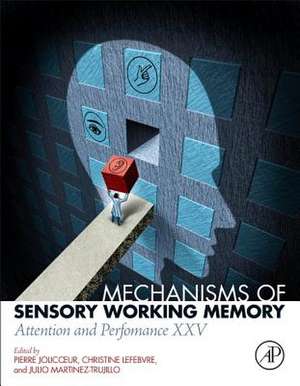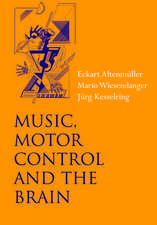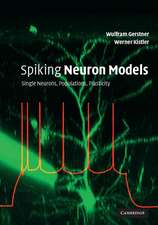Mechanisms of Sensory Working Memory: Attention and Perfomance XXV
Editat de Pierre Jolicoeur, Christine Lefebvre, Julio Martinez-Trujilloen Limba Engleză Hardback – 7 iul 2016
This contemporary focus on sensory memory is just beginning, and this collection of original contributions provides a foundational reference for the study mechanisms of sensory memory. Students, scholars, and researchers studying memory mechanisms and processes in cognitive neuroscience, cognitive science, neuroscience, and psychology will find this book of great value to their work.
- Introduces the study of sensory mechanisms of working memory as distinct from verbal memory
- Covers visual memory, auditory memory, and tactile memory
- Includes translational content as the breakdown of working memory is often associated with a disease, disorder, or trauma to the brain
Preț: 538.91 lei
Preț vechi: 744.82 lei
-28% Nou
Puncte Express: 808
Preț estimativ în valută:
103.15€ • 112.08$ • 86.70£
103.15€ • 112.08$ • 86.70£
Carte tipărită la comandă
Livrare economică 14-28 aprilie
Preluare comenzi: 021 569.72.76
Specificații
ISBN-13: 9780128110423
ISBN-10: 0128110422
Pagini: 312
Dimensiuni: 216 x 276 x 23 mm
Greutate: 1.07 kg
Editura: ELSEVIER SCIENCE
ISBN-10: 0128110422
Pagini: 312
Dimensiuni: 216 x 276 x 23 mm
Greutate: 1.07 kg
Editura: ELSEVIER SCIENCE
Public țintă
Cognitive Neuroscience, Cognitive PsychologyCuprins
Chapter 1. Introduction
Chapter 2. Sensational Memorability: Working Memory for Things We See, Hear, Feel, or Somehow Sense
Chapter 3. The Brain Mechanisms of Working Memory: An Evolving Story
Chapter 4. The Contribution of Human Superior Intraparietal Sulcus to Visual Short-Term Memory and Perception
Chapter 5. Neural Bases of the Short-term Retention of Visual Information
Chapter 6. What are the Roles of Sensory and Parietal Activity in Visual Short-Term Memory?
Chapter 7. Hemispheric Organization of Visual Memory: Analyzing Visual Working Memory With Brain Measures
Chapter 8. Visual Working Memory and Attentional Object Selection
Chapter 9. Individual Differences in Visual Working Memory Capacity: Contributions of Attentional Control to Storage
Chapter 10. Working Memory and Aging: A Review
Chapter 11. Defining a Role for Lateral Prefrontal Cortex in Memory-Guided Decisions About Visual Motion
Chapter 12. Working Memory Representations of Visual Motion along the Primate Dorsal Visual Pathway
Chapter 13. Neurophysiological Mechanisms of Working Memory: Cortical Specialization and Plasticity
Chapter 14. Neural and Behavioral Correlates of Auditory Short-Term and Recognition Memory
Chapter 15. Brain Activity Related to the Retention of Tones in Auditory Short-Term Memory
Chapter 16. The Interplay Between Auditory Attention and Working Memory
Chapter 17. Neuroimaging of the Mind’s Ear Using Representational Similarity Analysis
Chapter 18. Remembering Touch: Using Interference Tasks to Study Tactile and Haptic Memory
Chapter 19. Human Cortical Representation of Tactile Short-Term Memory for Stimulation Patterns on the Hand: Evidence From Magnetoencephalography
Chapter 20. The Role of Spatial Attention in Tactile Short-Term Memory
Chapter 2. Sensational Memorability: Working Memory for Things We See, Hear, Feel, or Somehow Sense
Chapter 3. The Brain Mechanisms of Working Memory: An Evolving Story
Chapter 4. The Contribution of Human Superior Intraparietal Sulcus to Visual Short-Term Memory and Perception
Chapter 5. Neural Bases of the Short-term Retention of Visual Information
Chapter 6. What are the Roles of Sensory and Parietal Activity in Visual Short-Term Memory?
Chapter 7. Hemispheric Organization of Visual Memory: Analyzing Visual Working Memory With Brain Measures
Chapter 8. Visual Working Memory and Attentional Object Selection
Chapter 9. Individual Differences in Visual Working Memory Capacity: Contributions of Attentional Control to Storage
Chapter 10. Working Memory and Aging: A Review
Chapter 11. Defining a Role for Lateral Prefrontal Cortex in Memory-Guided Decisions About Visual Motion
Chapter 12. Working Memory Representations of Visual Motion along the Primate Dorsal Visual Pathway
Chapter 13. Neurophysiological Mechanisms of Working Memory: Cortical Specialization and Plasticity
Chapter 14. Neural and Behavioral Correlates of Auditory Short-Term and Recognition Memory
Chapter 15. Brain Activity Related to the Retention of Tones in Auditory Short-Term Memory
Chapter 16. The Interplay Between Auditory Attention and Working Memory
Chapter 17. Neuroimaging of the Mind’s Ear Using Representational Similarity Analysis
Chapter 18. Remembering Touch: Using Interference Tasks to Study Tactile and Haptic Memory
Chapter 19. Human Cortical Representation of Tactile Short-Term Memory for Stimulation Patterns on the Hand: Evidence From Magnetoencephalography
Chapter 20. The Role of Spatial Attention in Tactile Short-Term Memory

















